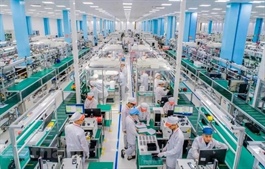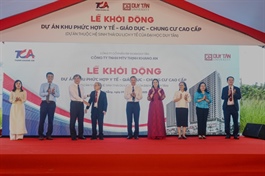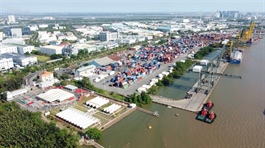Socioeconomic development intertwined with three pillars
Socioeconomic development intertwined with three pillars
The three pillars of science and technology, innovation, and digital transformation are considered the central driving forces that contribute to creating socioeconomic development gains.
For the first time, these three pillars are overseen in one resolution, under the management of one ministry. Few countries recognise the importance of these three pillars and merge them into one management, but Vietnam is among the pioneers in this approach.

Hoang Minh, deputy Minister of Science and Technology |
For Vietnam, these pillars are a mandatory choice and an opportunity for Vietnam to become powerful in the new era.
Science and technology is the foundation for creating new knowledge and tools. Innovation is the driving force, transforming them into ideas and solutions to solve socioeconomic problems. And digital transformation creates an environment to realise innovative solutions into new products, services, processes, and business models, popularising them to create real value.
Vietnam has made remarkable achievements in sci-tech. Fields such as biotechnology, new materials, and renewable energy have made progress, for example in producing vaccines, agricultural production, renewable energy, the green economy, and more.
However, there is still a gap: spending on research and development (R&D) is only about 0.5 per cent of GDP, lower than the world average of 2.4 per cent. The target is that by 2030, R&D spending will reach 2 per cent of GDP, with society contributing over 60 per cent of total spending on science and technology.
To boost this pillar, it is necessary to focus on the following solutions: perfecting institutions, encouraging private investment in R&D; developing personnel, with the goal of reaching 12 researchers per 10,000 people by 2030; investing in upgrading science and technology infrastructure, modernising labs, and bringing basic research to universities; having a tax discount policy for sci-tech development expenses of enterprises; and focusing on strategic tech that creates high-quality development, high added value, and a foundation for other industries.
This pillar not only contributes to increasing labour productivity but also promotes sustainability, such as applying green tech to reduce carbon emissions, towards the goal of carbon neutrality by 2050. In the next decade, science and technology will be the key for Vietnam to achieve double-digit GDP growth.
The second pillar is innovation, which is the driving force to turn ideas into economic value. It will help Vietnam overcome the middle-income trap by boosting the national innovation system and creative startup ecosystem.
It will also contribute to improving competitiveness, helping Vietnam rank in the world’s top 30 in the innovation index by 2045, and encourage sustainable growth through green economic and circular economic models.
The current situation shows that Vietnam has a vibrant startup ecosystem, with more than 3,000 startups by 2024, and venture capital investment reaching $1 billion. Successful examples include VinFast electric cars or FPT with AI software. However, the number of patents is still low, and the commercialisation rate is only 5-7 per cent. The target is to increase patent applications by 16-18 per cent a year, and commercial exploitation to reach 8-10 per cent.
Main solutions include building a national innovation system and nationwide startup ecosystem, connecting universities, research institutes, and businesses; strengthening intermediary organisations such as innovation support centres; providing financial support through venture capital funds; and developing high-tech parks in Hanoi, Danang, Ho Chi Minh City, Can Tho, and elsewhere to entice foreign investment.
The third is digital transformation, which needs new institutions. Many new aspects of the digital environment can challenge and destroy old models (for example, e-banking challenges traditional banking). Therefore, it is more of an institutional issue than a technological issue.
Vietnam ranks 52nd out of 193 countries in the E-Government Index in 2024, with 80 per cent of public services online at level 4, while the digital economy reached 16 per cent of GDP in 2024. However, challenges include digital infrastructure, cybersecurity, and skills. The country targets a digital economy of 30 per cent of GDP in 2030, nationwide 5G coverage, and 80 per cent cashless transactions.
Digital transformation will be a driving force for rapid growth, helping GDP increase by 1.5-2 per cent per year by optimising management, governance and production processes.
Solutions include building modern infrastructure, including a national data centre, universalising relevant skills, ensuring cybersecurity, deploying smart cities in major cities, and attracting the world’s leading tech companies.
Over the past 35 years, more than 30 countries have gone from middle income to high income. But only 10-12 are considered developed, such as South Korea, Israel, Czechia, and Poland. These are countries that have achieved high income through sci-tech, innovation, digital transformation, high level of industrialisation, high labour productivity, stable institutions, modern infrastructure, and developed education and healthcare systems.
Vietnam aims for both goals: to be high income and developed. To achieve this, the contribution to GDP growth of the three pillars must be over 50 per cent.
- 10:41 08/09/2025























